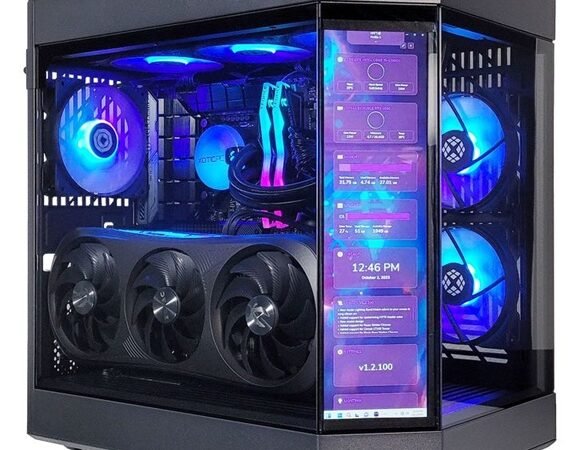Technewztop. com WiFi: Everything You Need to Know About Wi-Fi Technology and Tips for Optimization

Introduction to Technewztop. com WiFi Technology
In today’s fast-paced digital world, a reliable and high-speed Wi-Fi connection is no longer a luxury—it’s a necessity. Whether you’re streaming your favorite shows, working from home, or gaming online, the quality of your Wi-Fi network can significantly affect your online experience. Technewztop. com WiFi, a leading tech news platform, provides users with the latest updates and insights into Wi-Fi technology, helping them optimize their networks for the best performance.
This article will explore Wi-Fi technology, common Wi-Fi issues, how to optimize your network, and everything you need to know to get the most out of your Wi-Fi connection.
What is Wi-Fi?
The Basics of Wi-Fi Technology
Wi-Fi, short for Wireless Fidelity, is a wireless networking technology that uses radio waves to provide high-speed internet and network connections. It allows devices like smartphones, laptops, and smart home gadgets to connect to the internet without needing physical cables, providing flexibility and mobility.
How Wi-Fi Works
Wi-Fi works by transmitting data using radio frequencies (typically 2.4 GHz or 5 GHz). A Wi-Fi router acts as a hub, receiving internet signals from your Internet Service Provider (ISP) and then broadcasting them wirelessly to devices in its range. Devices equipped with Wi-Fi receivers can connect to this signal, enabling internet access.
The Evolution of Wi-Fi: From 802.11 to Wi-Fi 6 and Beyond
A Brief History of Wi-Fi Standards
Wi-Fi technology has evolved significantly since its inception. The 802.11 standards, developed by the IEEE (Institute of Electrical and Electronics Engineers), form the basis for Wi-Fi technology. Over the years, Wi-Fi has evolved through several versions:
- 802.11b/g/n: Older standards, providing moderate speeds.
- Wi-Fi 4 (802.11n): Introduced faster speeds and better coverage.
- Wi-Fi 5 (802.11ac): Brought gigabit-level speeds and introduced dual-band functionality.
- Wi-Fi 6 (802.11ax): The latest generation, offering even faster speeds, better efficiency, and the ability to handle more devices simultaneously.
What’s New with Wi-Fi 6?
Wi-Fi 6 offers a significant upgrade over previous generations, especially in crowded environments. It supports faster speeds, lower latency, and the ability to handle more devices on the same network. Wi-Fi 6 also introduces OFDMA (Orthogonal Frequency Division Multiple Access), which helps manage traffic more efficiently, especially in busy networks like homes filled with smart devices.
Common Wi-Fi Issues and How to Fix Them
Slow Wi-Fi Speeds
Slow Wi-Fi speeds are one of the most frustrating issues users face. If your Wi-Fi is sluggish, consider the following fixes:
- Restart your router.
- Ensure you’re using the correct frequency band (5 GHz for faster speeds, 2.4 GHz for longer range).
- Reduce interference by moving your router away from walls, microwaves, and other electronics.
Intermittent Connection Drops
If your connection keeps dropping, it could be due to outdated firmware, too many devices on the network, or interference from neighboring networks. Updating your router’s firmware and reducing the number of connected devices can often help.
Limited Coverage Areas
If some areas of your home experience weak or no Wi-Fi signal, it’s likely a range issue. This can often be solved by moving your router to a central location, upgrading to a Wi-Fi extender or mesh network, or adjusting your router’s settings for better coverage.
Technewztop.com Wi-Fi Optimization Tips
How to Boost Wi-Fi Speeds
Boosting your Wi-Fi speed doesn’t always mean upgrading your internet plan. Simple adjustments like:
- Upgrading to a faster router with Wi-Fi 6 capabilities.
- Switching to the 5 GHz frequency for faster, less congested connections.
- Limiting the number of devices connected simultaneously. These steps can result in noticeable speed improvements.
Maximizing Router Placement
Placing your router in a central location with minimal obstructions ensures better signal distribution. Avoid placing it near walls or metal objects, and elevate the router if possible for optimal signal strength.
Upgrading Your Equipment
If your router is several years old, it might be time to upgrade. Newer routers support higher speeds and advanced features like MU-MIMO (Multi-User, Multiple Input, Multiple Output), which improves performance in multi-device environments.
The Importance of Wi-Fi Security
Securing Your Network: WEP, WPA, WPA2, and WPA3
Wi-Fi security is crucial to protecting your data. There are various security protocols to safeguard your network:
- WEP (Wired Equivalent Privacy): An outdated and insecure protocol.
- WPA (Wi-Fi Protected Access): More secure than WEP but still vulnerable to attacks.
- WPA2: A widely used and secure protocol, but newer technology is available.
- WPA3: The latest and most secure protocol, offering enhanced protection, especially for open networks.
Tips for a Secure Wi-Fi Network
To secure your Wi-Fi:
- Use strong passwords and avoid default settings.
- Enable WPA3 (if supported by your router).
- Regularly update your router’s firmware.
- Disable remote management to prevent unauthorized access.
How to Choose the Best Wi-Fi Router for Your Needs
Important Features to Look For in a Router
When choosing a router, consider:
- Speed capabilities: Look for routers that support at least Wi-Fi 5 (or Wi-Fi 6 for future-proofing).
- Dual-band or tri-band functionality to reduce congestion.
- MU-MIMO and beamforming for better device connectivity.
Dual-Band vs. Tri-Band Routers
Dual-band routers operate on both 2.4 GHz and 5 GHz frequencies, while tri-band routers add an extra 5 GHz band, helping to reduce congestion and improve overall performance, especially in large households with many devices.
Understanding Wi-Fi Extenders and Mesh Networks
What Are Wi-Fi Extenders?
Wi-Fi extenders are devices that boost your Wi-Fi signal by receiving the signal from your router and rebroadcasting it. They’re ideal for eliminating dead spots in large homes but may sometimes result in slower speeds.
Mesh Networks: The Future of Home Wi-Fi
Mesh networks are an advanced alternative to traditional Wi-Fi extenders. Instead of boosting a single signal, mesh networks use multiple devices (or nodes) that communicate with each other, providing seamless coverage throughout the home without sacrificing speed.
Public Wi-Fi: The Pros and Cons
Benefits of Using Public Wi-Fi
Public Wi-Fi networks offer convenience, especially when traveling or working outside the home. They allow easy access to the internet without using mobile data.
Risks and How to Stay Safe on Public Networks
However, public Wi-Fi comes with security risks. Hackers can intercept data on unprotected networks, leading to potential theft of personal information. To stay safe:
- Use a VPN (Virtual Private Network) to encrypt your connection.
- Avoid accessing sensitive information, like banking, on public Wi-Fi.
- Always ensure the network is secured (look for the padlock symbol in the URL).
The Future of Technewztop. com WiFi Technology
Wi-Fi 6E and Wi-Fi 7: What to Expect
Wi-Fi 6E expands on Wi-Fi 6 by introducing the 6 GHz band, offering faster speeds and more channels for less interference. Wi-Fi 7 is on the horizon, promising speeds up to four times faster than Wi-Fi 6, with ultra-low latency that will be ideal for gaming, virtual reality, and real-time streaming.
How Wi-Fi is Revolutionizing Smart Homes
As smart home technology becomes more common, Wi-Fi will play a crucial role in connecting various devices like smart lights, security systems, and appliances. The evolution of Wi-Fi will make smart homes more responsive, efficient, and integrated.
How to Check Wi-Fi Speed and Performance

Tools for Measuring Wi-Fi Speed
To check your Wi-Fi speed, you can use tools like Speedtest by Ookla, Google’s speed test, or apps provided by your ISP. These tools measure your download, upload, and ping speeds to give you an accurate assessment of your Wi-Fi performance.
Understanding Wi-Fi Speed Test Results
When running a speed test, pay attention to:
- Download speed: Measures how fast you can receive data.
- Upload speed: Measures how fast you can send data.
- Ping or latency: Reflects the delay in data transmission, important for gaming and video calls.
Wi-Fi vs. Ethernet: Which One Should You Choose?
Pros and Cons of Wi-Fi and Wired Connections
Wi-Fi offers the benefit of mobility and flexibility, but Ethernet connections are typically faster and more reliable for bandwidth-heavy tasks like gaming or streaming in 4K. However, Ethernet requires physical cables, which can be inconvenient in larger homes.
When to Use Wi-Fi vs. Ethernet
Use Wi-Fi for everyday tasks like browsing or streaming on mobile devices, but opt for Ethernet if you need maximum performance for activities like online gaming or video editing.
Wi-Fi and the Internet of Things (IoT)
How Wi-Fi Powers Smart Devices
Wi-Fi is the backbone of the Internet of Things (IoT), connecting devices like smart thermostats, security cameras, and voice assistants. As more homes adopt IoT devices, having a strong, reliable Wi-Fi network is essential for seamless operation.
Wi-Fi and IoT Security Considerations
With more devices connected to your Wi-Fi, security becomes even more critical. Ensure each IoT device is regularly updated, use strong passwords, and consider segmenting your network with a guest network to isolate your IoT devices.
Technewztop. com WiFi Recommendations for Better Connectivity
Best Practices for Home Wi-Fi
To ensure you get the best Wi-Fi experience at home:
- Keep your router’s firmware up-to-date.
- Place your router in an open, central location.
- Upgrade to a Wi-Fi 6 router if you have multiple smart devices.
Affordable Wi-Fi Solutions for Better Coverage
For improved coverage without breaking the bank, consider:
- Investing in a mesh network or Wi-Fi extender.
- Using powerline adapters to extend your network through your home’s electrical wiring.
Conclusion
Wi-Fi is an integral part of modern life, and optimizing your connection can greatly enhance your online experience. With the insights and recommendations from Technewztop .com WiFi, you can improve your network’s speed, coverage, and security while staying up-to-date with the latest advancements in Wi-Fi technology. From troubleshooting slow speeds to understanding new Wi-Fi standards, mastering your home network will ensure you stay connected wherever you are.
FAQs About Technewztop.com Wi-Fi
- What is Technewztop. com WiFi 6, and how is it different from previous versions?
Wi-Fi 6 offers faster speeds, better performance in crowded environments, and improved efficiency over older versions like Wi-Fi 5. - How can I improve my Wi-Fi signal at home?
Improving Wi-Fi signals can be done by upgrading your router, repositioning it in a central location, or using Wi-Fi extenders or mesh networks. - Is public Wi-Fi safe to use?
Public Wi-Fi can pose security risks. To stay safe, use a VPN, avoid accessing sensitive information, and only connect to secured networks. - What’s the difference between a Wi-Fi extender and a mesh network?
A Wi-Fi extender boosts the signal from your router, while a mesh network provides a seamless, interconnected system of nodes for better overall coverage. - Can I use both Wi-Fi and Ethernet at the same time?
Yes, you can use both Wi-Fi and Ethernet simultaneously, with Ethernet often providing a faster, more stable connection for specific devices.
Also, Read About, Role of 172.16.50.4 in Networking.





